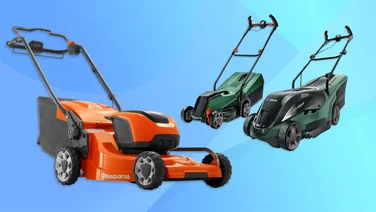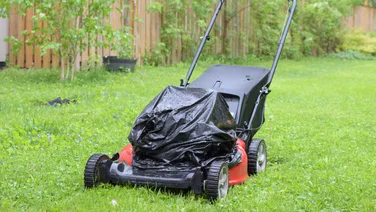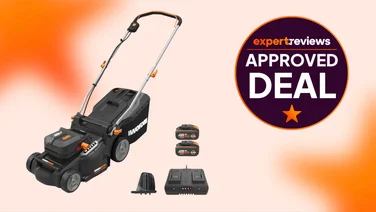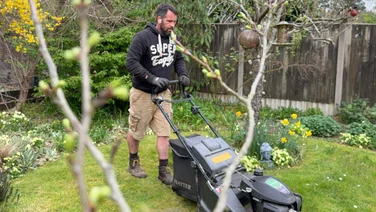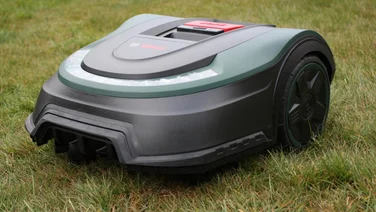To help us provide you with free impartial advice, we may earn a commission if you buy through links on our site. Learn more

How to mow a lawn properly is a prospect many find daunting. Whether you’ve never had a garden to look after before or are searching for tips to improve the appearance of your lawn this year, keeping your grass in trim isn’t always as straightforward as it may seem. Skipping vital lawn preparation and poor mowing can result in a messy and uneven job, long straggly edges and even cause accident or injury. Finding the best lawn mower possible to replace your old grass cutting machine is a good place to start.
The good news is that mowing a lawn properly is actually quite simple once you’ve learned a few ground rules. Even if you’re not remotely green-fingered, with a few essential garden tools and a bit of knowledge you’ll be well on your way to a perfectly manicured lawn.
From investing in a roller mower to create sought-after stripes to collecting clippings for composting – there are a number of things you can do to become a grass cutting pro. In this helpful explainer we’ll take you through these little extras as well as spelling out the basics on how to mow your lawn step-by-step.
When should I mow my lawn?
It’s wise not to do this too early in the year. Nick Ee, product and training manager at Black+Decker says, “The general rule is that you should perform the first grass cut of the year in early spring.”
Weather dependent, it’s likely that you’ll need to continue mowing up until around October, though the increasingly mild weather may mean extending this a little longer. Bear in mind it’s important to avoid wet days when operating machinery because it’s unsafe and grass can’t be cut cleanly. Whatever the season, you shouldn’t attempt to mow when the ground is very soft, or frozen.
In terms of the best time of day, Nick advises avoiding mornings: “This is generally the worst time to cut the grass as it’s usually wet from morning dew, rain or irrigation, making it hard for your mower to do its job.”
So afternoons are best, but during high temperatures you should also avoid the hottest part of the day to prevent newly cut grass from scorching in the heat.
READ NEXT: Best cordless lawn mowers
How often should I mow my lawn?
“Regular mowing helps eliminate weeds and encourages denser ground,” Nick explains. “I would recommend doing so at least once a fortnight.”
If your grass is looking particularly lush then you can increase mowing to around once a week during summer to keep it looking tip-top, though dry periods will require less frequent mowing. Keeping a section back, allowing it to grow in an “untamed state” is also popular. Nick says, “If you’re looking to encourage wildlife, longer grass will provide food and shelter for some animals.”
How do I choose a lawn mower?
Shopping for a new mower? Be sure to check out our guide to the best lawn mowers, but here’s a brief overview of what to look for.First, consider your lawn size. A tennis court-sized lawn is considered average in the “lawn mowing world”. Grass sections smaller than this can be easily maintained with lighter, lower-powered machines. You may find cordless mowers to be a good option as the battery life will be sufficient for servicing a small- to medium-sized lawn – not always the case with larger plots. Cordless mowers like the Worx WG779E.2 are quieter, require less maintenance and are more environmentally friendly.
Gardens larger than average may benefit from a petrol mower to take some of the legwork out of caring for a significantly bigger lawn; these are more powerful and can cope with longer grass but come at a price. You can also look at standard electric mowers, taking into consideration the cable length and whether you will need to invest in an extension cable to reach the farthest parts of your lawn from the mains power source. Of course, if we’re talking about very large gardens then who can resist a ride-on mower, budget permitting?
READ NEXT: Best petrol lawn mowers
What do I need?
Invest in a few key pieces of garden equipment for best results and safety:
- Safety goggles
- Sturdy shoes (please do not mow in flip flops)
- Gardening gloves
- Lawn rake
- Lawn mower
- Extension cable if required
- Edging tools and secateurs
- Strimmer
Do I need to prepare my lawn for mowing?
In a word, yes. Mowers can’t perform properly unless there’s clear access to the grass, and leaving loose stones and clutter around can cause significant injury when they meet a propeller blade.
Nick says, “Start by clearing away any debris like grass clippings, stray leaves and mud. Raking away moss regularly and removing old grass or leaves from the surface of the lawn is also important because if left, the layers of thatch will encourage weeds to grow.”
Clear the lawn of furniture, sport equipment and toys before you begin too, so you can mow freely.
What height should my lawn mower blades be?
The first cut of the season will need to be the highest possible in order to tackle the longer grass. Nick says the optimal height for your mower’s blades will depend on the type of grass you have.
“Follow the one-third rule,” he advises. “This means you should avoid cutting more than a third of the grass blade length in a single mowing session. The blade height also depends on the season. I’d advise cutting the grass slightly higher during periods of active growth and lower the trim height while the grass is growing at a slower rate.”
What should I do with my lawn clippings?
This is a matter of choice, but one thing you definitely shouldn’t do is to leave them in the clippings box of your mower as this will prevent it from working effectively and may lead to clumps being left on the lawn as it overflows – so be sure to empty regularly as you mow.
If your mower naturally mulches grass, you may choose to leave the clippings on the lawn; short clippings aren’t unsightly and they act as a protective layer, adding moisture to the remaining grass which is particularly useful in dry periods.
If you prefer a neater look, you can collect clippings and use them as a fertiliser for your bushes, or choose to compost them. If your grass has been treated with weed killer or similar, however, it’s best to dispose of them in your garden or household waste.
How do I create a striped lawn?

Once you’ve mastered the basics of mowing you may set your sights on picture-perfect Wembley stripes. This is best achieved using a mower with a rear roller, like the “brilliant all-rounder” Bosch Rotak 34R, and a pristine weed and moss-free lawn. With these, the roller flattens the remaining grass after cutting, leaving it lying in one direction. To create that must-have striped effect, simply mow stripes in alternate directions so that the glass blades reflect the light differently. Make sure you mow in the same direction each time you cut the grass to encourage growth in the right direction over time.
READ NEXT: Best cordless strimmers
How to mow a lawn: step-by-step:
Check that the weather, soil and grass conditions are suitable for mowing. The lawn shouldn’t be wet or frozen and soil needs to be firm enough to prevent the wheels from becoming stuck in the mud. Don’t mow in the rain or scorching heat.
Clear the lawn. This means moving furniture, pet toys and any equipment onto patio or decked areas before removing any visible leaves, loose moss or stones using a rake.
Set your mower blades at the correct level. The first cut of the year requires the blades to be set at the highest level. After that, keep grass between 2 to 4cm tall according to personal preference and grass type. Generally, aim to remove one-third of the height of the grass at each cut.
Cut around the edge of the grass first to set your area to work within and create neat turning circles, then starting from one edge mow up and down the lawn in straight lines. This works best for square or rectangular lawns, and you may need to divide irregular shaped gardens in half and deal with one side at a time otherwise.
Empty the clippings box before it gets too full, if your mower has one. You can collect clippings in a large bag to redistribute or compost after mowing.
Strim the edges, pathways and around beds for a neat finish by holding the trimmer at a 90-degree angle with the guard facing you to prevent injury. If you don’t have a strimmer you can do this manually with long-handed edging shears.
Clear away any clippings as desired.

